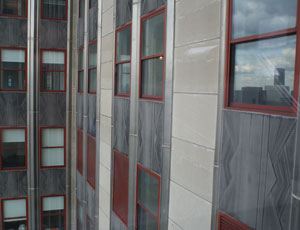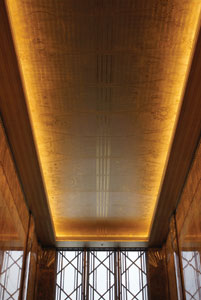An Economic Approach to Retrofits
Air handler units are being replaced with variable-frequency drive fans for better efficiency and more tenant control. Occupied spaces will have demand-control ventilation and air quality monitoring, and the whole building will get an upgrade of existing building controls for better HVAC performance, with the addition of metering.


“It was challenging exploring ides that might not be implemented, looking at the ideas on the edges of the bell curve, not the middle of the road,” says Carol Fluhrer, RMI’s energy consultant. “And it’s never been done on such scales. It was challenging to not be creative.”
The rest of the process has everything to do with the collaboration.
“You’ll notice the technologies are very mundane, but the process we used to arrive at that was somewhat unique,” Rode says. “I’m a Manhattan College grad and I’m working with a team of PhDs. It was a great experience, but we had to pay a lot of attention to not stifle the spirit of innovation.”
The Partners
Johnson Controls: A 125- year-old company with more than 140,000 employees that currently focus on technology integration services and energy products, serving more than 200 million vehicles, 1 million commercial buildings, and 12 million homes across 125 countries. Their building efficiency business includes building management systems, integrated HVAC systems, and energy and sustainability solutions.
Jones Lang LaSalle: A real estate facility management company with a portfolio of 1.4 billion sq ft, $46 billion of assets under management, with a 2008 revenue of $2.7 billion and more than 750 clients in 60 countries. Its core services include leasing, investment and property management, and energy and sustainability services. It counts 380 LEED-accredited professionals on its staff and has 116 LEED projects worldwide. In the United States, that totals 35 million sq ft.
The Rocky Mountain Institute: The “special sauce,” as LaSalle’s Qaurtararo describes them, is a non-profit started in 1982 by experimental physicist and prolific author, Amory Lovins, to focus on energy policy. Now counting a staff of 80 and a $12 million annual budget, RMI has led the redesign of $30 billion worth of facilities and consulted 19 heads of state on energy and resource efficiency.
The Clinton Climate Initiative: Started in 2006 to do pro-bono work in clean energy, forestry and urban renewal areas, focusing on emissions-reducing projects. Their services cover everything from recommending project best practices, through planning and coordination, to financing consultation. At its essence, however, CCI acts as a facilitator – not unlike the friend who is always able to introduce you to the right people.
“Our resources are not financial – we come as a catalyst,” says Baczko. “We are not a funding organization, and we’re not there to subsidize, but we do bring players to the table.”
“[Bill] Clinton likes to say that we’re all about bringing the how-to people,” Shuur adds.
CCI’s scope is international. Its recent projects include getting 14 cities worldwide to work with vehicle manufacturers to create electric, vehicle-friendly environments; the first integrated waste management system in India, covering everything from the door to disposal; and solar power generation research in South Africa and India. To date, CCI has been a partner on more than 250 retrofits in 20 cities around the world, from affordable housing in Chicago to massive integrated systems in Melbourne, Australia. CCI works with commercial buildings as well, currently assisting on a mall retrofit in India, a multi-building retail and entertainment project in Seoul, as well as Chicago’s Merchandize Mart, the world’s largest commercial building at 4.5 million sq ft, where the work has already resulted in CO2 reduction of more than1,200 tons per year and electricity use reduction of 2.2 million Kwh.
CCI’s work on the ESB has already attracted several building owners internationally, although CCI was not willing to share names just yet. Here in New York, CCI is already working with the New York Housing Authority, the Department of Education and the Green School Alliance. Nonetheless, Baczko says, “the commercial sector is the most challenging, clearly, because of the split incentives and the short-term payback expectations.”
More Numbers
Commercial and residential buildings account for an estimated 70 percent of the carbon footprint in New York City. By 2030, buildings that already exist today will account for around 85 percent of them. The Empire State Building was found to be America’s No. 1 favorite building in a poll by the American Institute of Architects. Its visibility is total. Its almost 40-percent energy reduction model is available to anyone with Internet access at www.esbsustainability.com.


Post a comment to this article
Report Abusive Comment